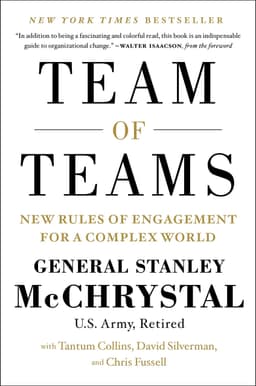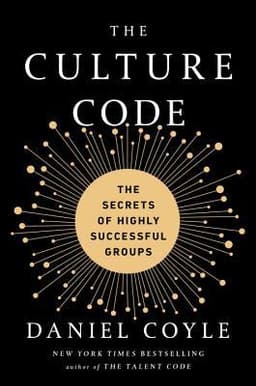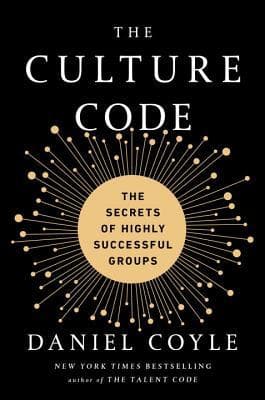
Team of Teams Book Summary
New Rules of Engagement for a Complex World
Book by Stanley McChrystal
Summary
In Team of Teams, General Stanley McChrystal shares powerful lessons on how organizations can adapt and succeed in complex, rapidly changing environments by breaking down silos, empowering teams, and fostering a culture of trust, transparency, and decentralized decision-making.
Sign in to rate
Average Rating: 5
The Unstoppable Rise of Al Qaeda in Iraq
In 2004, the U.S. military's Joint Special Operations Task Force was struggling against Al Qaeda in Iraq (AQI) despite having more resources, better training, and advanced technology. AQI proved to be a resilient and adaptable foe, able to survive leadership losses and quickly regenerate. Led by Abu Musab al-Zarqawi, AQI engineered a campaign of brutal violence, bombing civilian targets and igniting a sectarian civil war in Iraq. The author, as commander of the Task Force, realized that AQI was a fundamentally different kind of enemy and the U.S. forces would have to adapt to have any hope of victory.
Section: 1, Chapter: 1
Realization That Organizational Change Was Needed
The author and Task Force leadership realized that to defeat an agile, networked enemy like AQI, they would have to drastically change their own organization. Efficiency alone was no longer enough - they needed adaptability. Some key insights:
- The Task Force's existing structure was too rigid and siloed to keep up with the speed of events in Iraq
- Information sharing and collaboration between different units was poor
- Authority was too centralized, inhibiting fast decision making by frontline troops
- The Task Force would need to transform into a flatter, faster, more integrated "team of teams" to win
Section: 1, Chapter: 1
The Enduring Legacy of Frederick Winslow Taylor's Scientific Management
Frederick Winslow Taylor pioneered the concept of "scientific management" in the early 20th century, seeking to optimize industrial efficiency through time-motion studies, process optimization, and centralized planning. His reductionist approach of breaking work down into specialized, repetitive tasks boosted productivity tremendously and left an enduring mark on management thinking across business, government and the military. However, the rigidity and top-down control inherent in "Taylorism" has limitations in environments with greater complexity and unpredictability.
Section: 1, Chapter: 2
Match Organizational Structure to the Environment
Taylorist management and rigid organizational structures work well when tasks and environments are predictable. But in fast-changing, complex environments, adaptability is key. Leaders must recognize when old models no longer fit and be willing to drastically change organizational structures, trading some efficiency for agility. Just as the industrial revolution demanded a management revolution, the information revolution demands new ways of organizing.
Section: 1, Chapter: 2
The Difference Between Complicated and Complex Systems
Understanding the difference between complicated and complex systems is key to managing in the modern world:
Complicated systems:
- Are rule-bound with predictable cause-and-effect relationships
- Consist of many parts, but connections between parts are fixed and straightforward
- Respond in expected ways to change - Optimal solutions can be planned in advance Examples: an assembly line, a Swiss watch
Complex systems:
- Consist of many interdependent parts with unpredictable, nonlinear relationships
- Produce emergent behaviors and effects that cannot be predicted just by looking at individual components
- Defy attempts to "solve" with reductionist planning and control Examples: the weather, a rainforest ecosystem, the global economy
Section: 1, Chapter: 3
The Mistake of Treating Complex Problems as Complicated Ones
Many intractable modern challenges arise from failing to distinguish between the merely complicated and the genuinely complex. Complicated problems can be hard, but with enough data and planning they can be "solved." Complex problems, by contrast, have no permanent solutions - only better or worse responses. Common mistakes:
- Seeking perfect, stable solutions rather than dynamic adaptations
- Excessive faith in more data leading to prediction and control
- Reductionist "divide and optimize" approaches that generate unintended consequences
- Expecting things to add up in a linear way rather than combining in unexpected ways
Instead, leaders must embrace uncertainty, focus on resilience and adaptability, and take an experimental, iterative approach.
Section: 1, Chapter: 3
From Clockwork to Complexity in Modern Warfare
In Iraq, the U.S. military confronted an environment that was not just complicated, but complex. A complicated environment, like the battlefields of the World Wars, still had a basic, underlying clockwork logic. But by 2004, the speed and interdependence enabled by new technologies had pushed things over the edge into complexity. Small events could spiral outward with disproportionate impacts. Insurgent tactics and civilian reactions seemed to shift constantly in unpredictable ways. Cause and effect were no longer straightforward. Precision plans quickly became irrelevant. The U.S. Task Force realized that rather than just doing complicated operations more efficiently, it would have to fundamentally transform to become an adaptable, complex system itself.
Section: 1, Chapter: 3
Adaptability Trumps Efficiency in Complex Environments
In complex environments, adaptability often matters more than raw efficiency in achieving goals. The author compares the U.S. military's struggles in Iraq to the experience of the Dutch fighting floods - in both cases, focusing only on efficiently executing existing plans proved less effective than building in resilience and flexibility to respond to changing circumstances. Being able to sense and adapt to change, even if it means sacrificing some efficiency, is key to success in a complex world.
Section: 1, Chapter: 4
Efficiency Versus Adaptability in Organizations
Many organizations pursue efficiency, trying to execute known processes as well as possible. But when the environment is uncertain, the ability to adapt is more important.
Efficiency:
- Doing things optimally based on predefined criteria
- Relies on prediction and planning; vulnerable to the unexpected
- Well-suited for complicated, knowable environments
Adaptability:
- Able to change to meet new circumstances
- Continuously evolves based on new information; tolerates the unexpected
- Needed in complex, unknowable environments
The key is matching the organizational approach to the environment. Too often, organizations default to chasing efficiency even when adaptability is needed.
Section: 1, Chapter: 4
How Small Teams Achieve Coordinated Adaptability
Small teams like Navy SEAL units can achieve remarkable feats of coordinated adaptation without detailed central planning. This adaptability emerges from extensive training that builds trust and common purpose among members. With shared consciousness and strong lateral ties, team members can autonomously make smart decisions that align with the team's goals. They don't need to wait for orders. While this agility is common in small teams, it's rare in large organizations, which default to top-down command structures.
Section: 1, Chapter: 5
Good Teams and Trust
"Great teams consist of individuals who have learned to trust each other. Over time, they have discovered each other's strengths and weaknesses, enabling them to play as a coordinated whole."
Section: 1, Chapter: 5
Trust and Purpose Allow Teams to Handle Complexity
For small teams to handle complex environments, they need two things:
- Trust: Faith in each other's reliability and commitment, often forged through shared experience and allowing autonomous action
- Common Purpose: A deep, shared understanding of the team's goals and context, so choices align without explicit coordination
When both are present, remarkable "emergent intelligence" is possible, with the team able to creatively solve problems no leader could have foreseen. But building this trust and purpose takes extensive, focused effort - it can't be shortcut. And without them, autonomy fails.
Section: 1, Chapter: 5
The Limits of a "Command of Teams" Structure
The U.S. Task Force's original structure was a "command of teams" - while individual SEAL, Ranger, etc. units were adaptable, the overall hierarchy was rigid. Units were highly independent and only loosely coordinated. This worked for limited, linear missions, but failed against the interdependent complexity of the Iraqi insurgency. Silos led to poor information flow between teams, and centralized decision-making couldn't keep up with the speed of events. The Task Force realized it needed to become a "team of teams," with rich linkages between its parts and the ability to combine efforts seamlessly.
Section: 1, Chapter: 6
"Shared Consciousness" as an Organizational Goal
To achieve "team of teams" adaptability at an organizational scale, the Task Force pursued "shared consciousness" - a holistic, ever-updated understanding of the entire mission shared by all. Key elements included:
- Extreme transparency of information across units, enabled by technology
- Rich lateral ties between units to build trust and awareness
- Instilling common purpose beyond just unit goals
- Leader emphasis on the "why" behind missions, not just the "what"
When every team understands the whole system and how their choices impact others, they can combine fluidly and adapt in sync. While never perfect, shared consciousness makes the "team of teams" approach viable even in very large organizations.
Section: 1, Chapter: 6
From Brittle Silos to Resilient Networks
Organizations tend to evolve in two major forms:
Brittle, Efficient Hierarchies:
- Siloed units with rigid vertical ties and weak lateral connections
- Centrally planned, narrowly focused action
- Struggle with complexity due to slowness and tunnel vision
Resilient, Adaptable Networks:
- Densely interconnected nodes with strong lateral ties
- Decentralized, autonomous action loosely guided by shared purpose
- Can adapt to complexity by reconfiguring resources and approaches
The former is often a legacy of industrial-era models; the latter is better suited for an information-age world.
Section: 1, Chapter: 6
Transparency and Information Sharing as a Foundation for Adaptability
To become an adaptable "team of teams," the U.S. Task Force had to fundamentally change how it shared information. Instead of hoarding intelligence in silos, it needed to make data widely accessible. This meant shifting from a "need to know" mindset to a "duty to share" one.
By making information transparent across the organization, frontline teams could act on intelligence faster, recombine data in creative ways, and avoid decisions that helped one unit but hurt the mission overall. While uncomfortable at first, this shift to "shared consciousness" proved crucial to success against Al Qaeda.
Section: 1, Chapter: 7
Doing the Right Thing
"Efficiency Is Doing Things Right; Effectiveness Is Doing the Right Thing"
"If you have enough foresight to know with certainty what the 'right thing' is in advance, then efficiency is an apt proxy for effectiveness. In the wayward swirl, however, the correlation between efficiency and effectiveness breaks down. The Task Force had built systems that were very good at doing things right, but too inflexible to do the right thing."
Section: 1, Chapter: 7
You Can't Predict What Information Matters, So Share Widely
In a complex environment, it's impossible to know in advance what information will be important. The most effective approach is broad transparency, so people can access the data they need when they need it. This means:
- Investing in knowledge sharing technology and processes
- Shifting culture from "need to know" to "duty to share"
- Encouraging people to pull information from other teams, not just push what they think matters
- Focusing on the accessibility of raw data, not just final analyses
When unexpected needs arise, a transparent information environment allows teams to quickly adapt rather than getting bogged down in requests and approvals.
Section: 1, Chapter: 7
The Daily O&I Briefing as an Adaptability Engine
The Task Force's daily Operations & Intelligence (O&I) briefing became the key mechanism for driving transparency and pushing decision-making down.
Key aspects included:
- Broad participation across units and ranks via technology
- Conversational format encouraging questions and debate
- Focus on surfacing diverse views vs. formal presentations
- Senior leader modeling of curiosity and humility vs. asserting rank
- Tying individual updates to whole-system view of the mission
Over time, the O&I created a shared consciousness, empowered frontline troops to make quick decisions, and fostered a "we're in this together" ethos.
Section: 1, Chapter: 8
In VUCA Environments, Make Decisions at the Point of Information
In volatile, uncertain, complex and ambiguous (VUCA) environments, centralized decision-making is too slow and uninformed to keep up. Instead, organizations must push decision rights out to the edges, where people have the most timely and relevant knowledge. This requires:
- Broad data transparency so frontline teams have necessary context
- Strong lateral connections for collaboration and information flow
- Training and trust so junior personnel are equipped to decide and act
- Cultural comfort with decisions being made below senior levels
- Senior leader focus on the "what" and "why," not dictating the "how"
Decentralized authority doesn't mean chaos - it means flexible unity of effort guided by commander's intent.
Section: 1, Chapter: 8
The Prisoner's Dilemma and the Need for Trust in Organizations
Even when information is widely shared, people still face incentives to "defect" rather than cooperate. In the classic game theory scenario of the Prisoner's Dilemma, two crime suspects are better off collectively if they stay silent, but as individuals they're tempted to betray each other for shorter sentences.
The same dynamics play out in organizations under pressure - without trust, people hoard resources, fail to coordinate, and make choices that hurt the overall mission. Building trust, so that people instinctively cooperate instead of defect, is key to organizational effectiveness.
Section: 1, Chapter: 9
Balancing Efficiency and Autonomy for Adaptability
Decentralized decision-making can feel chaotic and inefficient compared to centralized control. But in complex environments, some inefficiency is a price worth paying for adaptability. To find the right balance:
- Make information transparent so edge teams have context for smart choices
- Communicate a clear Commander's Intent so subordinates understand the "why"
- Push resources and authority to the edge so frontline teams can act quickly
- Set "boundaries" on autonomy based on risk and competence, not hierarchy
- Focus senior leaders on strategic decisions, not tactical micromanagement
The result is "eyes on, hands off" oversight - leaders who can see what's happening, but trust subordinates to steer the ship.
Section: 1, Chapter: 10
The Ineffective "Hero-Leader" in Complex Environments
The traditional model of the "hero-leader" who has all the answers and controls every decision is appealing, but ineffective in a complex world. Leaders who try to know and direct everything quickly become overwhelmed by the volume and velocity of decisions, creating organizational bottlenecks. They also stifle the expertise and initiative of frontline teams who often have better information. Instead of the hero-leader, complex environments require "gardener-leaders" who focus on creating the right conditions for success and empowering subordinate decision-making.
Section: 1, Chapter: 11
How Mayor Giuliani Led During 9/11 by Empowering Teams
On September 11th, 2001, New York City Mayor Rudy Giuliani faced an unprecedented crisis. Instead of trying to personally direct every aspect of the response, he focused on setting priorities, making big decisions, and empowering teams.
Giuliani had built strong relationships with his chiefs ahead of time and trusted their expertise. On 9/11, he gave them clear direction and authority to adapt as needed, without micromanaging. He focused on the What and Why, letting them handle the How. When communications broke down, teams were able to improvise and coordinate on the fly because they understood the overall intent. Giuliani's "gardener" approach, while imperfect, helped NYC respond and bounce back faster than a centralized response could have.
Section: 1, Chapter: 11
To Lead Adaptable Teams, Focus on Conditions and Context
For leaders looking to build more adaptable teams, the key is to focus on creating the right conditions for success:
- Communicating clear priorities and intent, but avoiding micromanagement
- Making information transparent so teams have context for smart decisions
- Shaping culture and incentives to encourage smart risk-taking and initiative
- "Eyes on, hands off" - monitoring execution, but resisting the urge to jump in
Shifting from hero to gardener means seeing leadership as an ongoing process of enabling, not a series of decisive interventions.
Section: 1, Chapter: 11
Thriving in a "VUCA" World Requires New Mental Models
The challenges the Task Force faced in Iraq are a microcosm of the Volatile, Uncertain, Complex, and Ambiguous (VUCA) world facing many organizations today. To thrive in this environment requires new ways of thinking and operating:
- From predictive planning to rapid adaptation and experimentation
- From siloed execution to transparent collaboration across boundaries
- From centralized control to decentralized initiative within a common framework
- From brittle efficiency to resilient networks able to respond to change
- From leaders with all the answers to leaders who empower others to find answers
While uncomfortable, these new mental models are essential for organizations to make the leap from 20th century bureaucracy to 21st century adaptability.
Section: 1, Chapter: 12
Related Content


The Culture Code Book Summary
Daniel Coyle
The Culture Code reveals the secrets of highly successful groups, showing that the key to unleashing a team's full potential lies in creating a culture of safety, shared vulnerability, and purpose.
The Culture Code reveals the secrets of highly successful groups, showing that the key to unleashing a team's full potential lies in creating a culture of safety, shared vulnerability, and purpose.
Leadership
Management
Business

